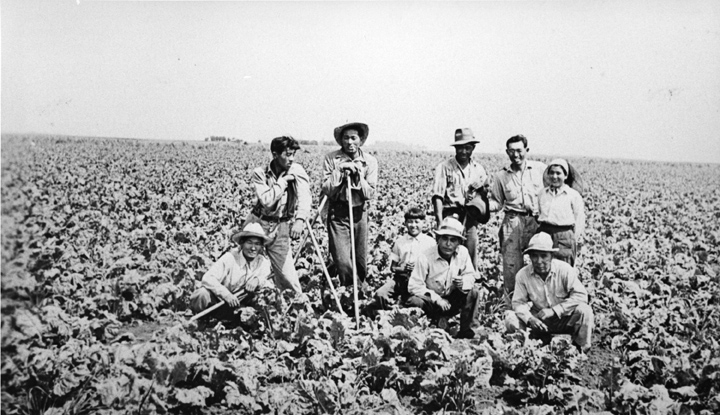Work & Labour Conditions
Contents: Sugar Beet Farms Additional Sources of Work Geography and Climate Describing Work in Letters
Sugar Beet Farms
Much of the work done by the families of the correspondents centres around sugar beet farming. The “option” to work on sugar beet farms provided an important opportunity for Japanese Canadian families to experience their forced removal from B.C. together rather than apart--options such as work camps were highly gendered in nature and led to the separation of men from women and children. According to scholars, this benefit of togetherness-in-forced-dispersal was something that was highly emphasized by the Canadian government when the sugar beet farming was presented to families 1.
Once they had agreed to the work and arrived in Alberta and Manitoba, Japanese Canadian families were met with incredibly poor living conditions, very little pay, and weather that dramatically affected their ability to work. However, although in some instances they had been promised relative freedom of movement, Shelley Ketchell notes, “it is clear that once they committed to the program, the choices were no longer their own. Choices, instead, became dictated by negotiations between the [British Columbia Security Commission] and towns and cities in Alberta and Manitoba”2.
You can learn more about the living conditions of our correspondents on the ‘Homelife’ page.
Why Sugar Beets?
Sugar beets are high in sucrose and are commonly used in Canada and the United States for the production of white sugar. In Canada, sugar beets are particularly valuable because Canada does not have the right climate to grow sugar cane, the other most common source of raw material for sugar. Sugar beets continue to be key to the production of sugar in Canada – in 2006, Statistics Canada estimated that farmers in Alberta produced 963,000 tonnes of sugar beets that went on to become 124,000 tonnes of beet sugar3; in 2018, 1.38 million tonnes of sugar beets were produced4.
For better or worse, staying together as a family in these conditions also meant working together as a family. Japanese Canadians of all ages and genders worked the beet farms, performing hard labour for long hours in order to scrape together enough money to live on.

There are many stages to beet farming, each of which requires a significant amount of work. Activities that the correspondents mention having to carry out included planting, thinning, hoeing, and harvesting--which in and of itself has a variety of stages including pulling, piling, topping, and loading.
To [top] this sugar beet we use a heavy knife with a curved hook at the end to pick it up. This we could only do about 1/2 acre a day or less. To every ton of beets topped we get $1.25 to 8 tons of beet topped and to anything over 8 tons an acre we get 1.00 per ton.
Farming in general is highly seasonal and doesn't offer much flexibility if the crop is to be successful. As a result, many of the correspondents who were able to remain in school often had to sacrifice weeks or months of their education so that they could help their families complete the harvest. You can learn more about the education of our correspondents on the 'Education' page.

Topping Knife
A topping knife that belonged to Roy and Lillie Yano, now held at the Nikkei National Museum (2013.57.3.4). Topping involves taking the green leaves off of the top of the sugar beet.
To read more of what correspondents wrote about the experiences working on beet farms and elsewhere, check out the ‘Labour conditions’ tag on the subject visualization page.
Additional Sources of Work
Not all forcibly displaced families worked sugar beet farms. Albert Ohama's family, for example, worked on a farm that appears from the letters to have had cows and horses and required the family to cut about 30 acres of hay. Although different from sugar beet farming, this work was no less grueling and still took up nearly all of the family's time5.
Be it sugar beets or other field work, the wages paid to Japanese Canadians for working these farms was not enough for families to make ends meet, especially if they were trying to pay for school. Family members ended up having to find other ways to make money within the bounds of the restrictions placed upon their movement and labour by the Canadian government. For some, this involved doing other work for their “boss” or helping out on larger farms that were being worked by other families. Other times this involved finding other types of work away from their families. Several of the correspondents note that members of their family, other Japanese Canadians, or they themselves were either thinking about or did travel eastward to find other work.

Image description: Yoshio Nakamura [left], Jackie Takahashi [right], and another Japanese Canadian boy riding a tractor.
Some families were able to take on additional work helping other families they knew from B.C. In one letter to Joan, Jackie mentions, ‘We finished thinning on Tuesday, July 1 around 4 P.M. We went up to Yosh’s place to help them thin their beets for a couple of days.’6
In addition to restrictions on location and types of labour, the types of work that Japanese Canadians could find greatly depended on their gender. Men tended to find work, as Jackie Takahashi did, in logging or other farming, while women were more likely to doing house-work or to find factory or administrative work in towns or major cities.
All I have to say is that I fail my grade, I intend to quit school and go out working. Probably house-working in winter and farming in summer. That’s about all the work there is for girls out here.
Geography and Climate
Weather greatly affected when and how work was able to get done. Many of the letters describe conditions in which it was impossible to keep working because of inclement weather. Other times, even when families could work, they had to do so in extreme weather conditions.
The toughest day we had out here was about 30 degrees below with a wind that almost tore our skins apart from our bones. This day me and my dad went out a mile to get beet leaves for our boss’s cattle. The beet leaves were stuck tight together so we needed a pick to separate them from the ground. My dad had 1 1/2 inches of [icicle] on his [mustache] when we came back with a load.
Nearly everyday except Sundays and 1st of July, I've been working out on the prairies. Wow! is it ever hot! We hayed for a week in the blazing heat. It was 114° F at 6 P.M. so you can guess how hot it was at 1 or 2 P.M. Sweat just pours down in streams and water just flows nearly continuously down the hatch. I guess we drink a gallon or two of water each day. I've been mowing and raking hay these last few days and we start to hay again on Thursday.
Describing Work in Letters
While they were quite candid about their experiences in their letters to Joan, it is noticeable that many of the correspondents tried to be optimistic about their situations, imagining how soon they could be home, that Joan could come visit, or that they might be able to move closer to make that happen.
Seriously, though, Joan, I’m not working that hard. The work has been hard but I’m getting use [sic] to it now. We’ve finished all the field work and there’s really not much work to do now. But there’s enough to keep us busy -- darn it. But don’t worry, Joan, I’m not working myself to death. Here pinch my arm. See, I’m alive. Ouch. (You pinched me too hard). Silly, ain’t I?
They also seemed to try to shield Joan from the worst of the conditions they were being forced to endure. The backbreaking labour of farming and the incredibly long hours that it required often left them with little energy to write, yet so many of them focused on hoping that Joan would forgive them for not having written back sooner, never mind the fact that the reason they hadn't was because of the monopoly that the work held over their time.
While many of the letters demonstrate how youthful these correspondents were, the manner in which they communicated their situations to Joan shows the maturity they were forced to develop when they were forcibly displaced. Making the best of a bad situation, they used their letters to hold onto their youth, but also could not help but omit some of the harshest elements of their experiences in acknowledgement of Joan's greater innocence back home.
Citations
1. Shelly D. Ketchell, “Re-locating Japanese Canadian History: Sugar Beet Farms as Carceral Sites in Alberta and Manitoba, February 1942 – January 1943,” (MA Thesis, University of British Columbia, 2005), 99.
2. Ibid.
3. Statistics Canada, “That beet is sweet!,” Canadian Agriculture at a Glance, April 4, 2009, https://www150.statcan.gc.ca/n1/pub/96-325-x/2007000/article/10576-eng.htm.
4. Glen Hallick, “Alberta, Ontario sugar beet producers hope for good year,” Markets Farm, July 19th, 2019, https://www.agcanada.com/daily/alberta-ontario-sugar-beet-producers-hope-for-good-year.
5. Albert Ohama, Letter to Joan Gillis - July 4, 1942.
6. Jackie Takahashi, Letter to Joan Gillis - July 24, 1942.